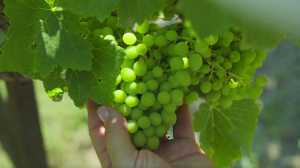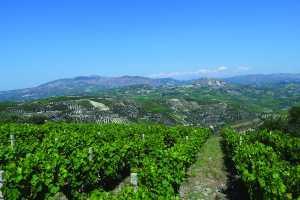Crete is one of Greece’s largest wine regions and is the largest Greek island. In terms of production, the lion’s share comes from the prefecture of Heraklion, followed by the prefectures of Chania, Rethimno and Lasithi. Its position in the southern part of Greece influences the island’s climate which is a typical warm Mediterranean climate. However, because of its size, Crete has a wide range of different mesoclimates and topographies.
The island faces the Aegean Sea to the north and the Libyan Sea to the south. A spine of mountains that run west to east across the island act as a barrier to warm-blowing winds coming from Africa. The mountains also provide variation in altitudes, aspects and soils. Vine growers have the option of planting high-altitude sites, securing much cooler mesoclimates than expected in such a southern latitude.

Crete has a wealth of native, high-quality grape varieties, and nowadays, Cretan producers focus on capitalizing on their potential. Vidiano is the rising star of the local vineyard, yet many other indigenous grapes such as dafni, plyto, muscat of Spina, romeiko and others mentioned below make up a complex mosaic of distinct aromas and flavours.

Crete has seven wine appellations, including two members of the Malvasia family of appellations. Five of them are located in Heraklion and two in the prefecture of Lasithi. PDO Sitia (ΠΟΠ Σητεία), in the eastern part of Crete (Lasithi), can be made as a white or red wine. The white PDO Sitia (ΠΟΠ Σητεία) is a blend of predominantly vilana together with thrapsathiri. The red PDO Sitia (ΠΟΠ Σητεία) is made from the noble Liatiko grape, with a small addition of mandilaria. The wines are pale to medium coloured, with complex and refined aromas of red dried fruits, dried herbs and spices. Tannins are perceptible and slightly dry; however, the best wines can age impeccably.

Liatiko also produces excellent, concentrated sweet wines under the PDO Sitia. There is also PDO Malvasia Sitia (ΠΟΠ Malvasia Σητείας) which is reserved for sweet white wines made from a blend of grape varieties.
PDO Dafnes (ΠΟΠ Δαφνές), for dry or sweet red wines; PDO Archanes (ΠΟΠ Αρχάνες) for dry reds; and PDO Peza (ΠΟΠ Πεζά), producing dry white and reds, are the three older appellations in Heraklion. PDO Dafnes (ΠΟΠ Δαφνές) are dominated by Liatiko with an optional addition of mandilaria in the blend.
PDO Archanes (ΠΟΠ Αρχάνες) and PDO Peza (ΠΟΠ Πεζά) are made from a blend of kotsifali and mandilaria. These two grapes complement each other. Kotsifali is pale-coloured with intense aromatics, low to moderate tannins and high alcohol, while mandilaria is deep-coloured with higher tannin levels and acidity. The white PDO Peza (ΠΟΠ Πεζά) is made from 100 per cent vilana, and the best examples are sourced from higher-altitude vineyards and poor soils that restrain yields.

The broad PDO Candia (Χάνδακας – Candia) (white or red) and the sweet-only PDO Malvasia Χάνδακας Candia are the two most recent appellations in Heraklion. The prefectures of Chania and Rethimno do not have any Protected Designations of Origin. However, producers may use the PGI Chania (ΠΓΕ Χανιά) or PGI Rethimno (ΠΓΕ Ρέθυμνο), as well as the PGI Crete (ΠΓΕ Κρήτη), which is the most common geographical indication on a bottle of Cretan wine and consists of all four geographical units of the island. Under these designations, they craft a number of wines in various styles and from different local and international grape varieties.
To learn more, follow Wines of Greece on Facebook, Instagram and YouTube.


